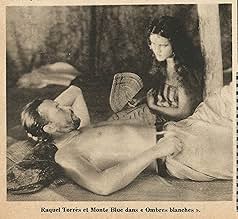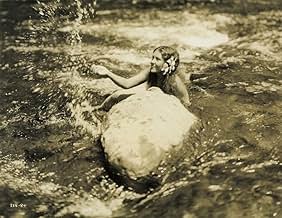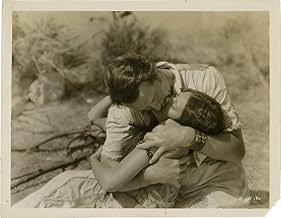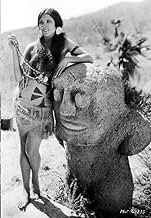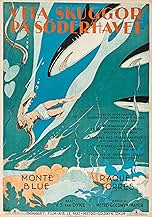VALUTAZIONE IMDb
6,8/10
1054
LA TUA VALUTAZIONE
Aggiungi una trama nella tua linguaAn alcoholic doctor on a Polynesian island, disgusted by white exploitation of the natives, finds himself marooned on a pristinely beautiful island.An alcoholic doctor on a Polynesian island, disgusted by white exploitation of the natives, finds himself marooned on a pristinely beautiful island.An alcoholic doctor on a Polynesian island, disgusted by white exploitation of the natives, finds himself marooned on a pristinely beautiful island.
- Regia
- Sceneggiatura
- Star
- Vincitore di 1 Oscar
- 1 vittoria in totale
Robert Anderson
- Sebastian - a Trader
- (non citato nei titoli originali)
Renee Bush
- Lucy
- (non citato nei titoli originali)
Dorothy Janis
- Native Girl
- (non citato nei titoli originali)
Napua
- Native Boy
- (non citato nei titoli originali)
Recensioni in evidenza
In this little-known Van Dyke picture, the brilliant cinematography and acting cancel out the shallow plot and seemingly endless 'docu-footage' of the island. What it all adds up to is a very interesting, beautifully shot representation of an exotic place, with a bit of heavy-handed message to make it a story rather than a documentary. There is one exception to this, though, and it is a stunning one: the scene in which the 'white god' teaches the girl to whistle. It is surprisingly intimate, and acted wonderfully well. I recommend this one to fans of early cinematography.
Monte Blue stars as Doc Lloyd, a drunk living like a bum among the French Polynesian natives who are being exploited by white traders for the nearby valuable pearl beds. The mistreatment of the locals reaches a breaking point for Doc, and after a violent outburst, he ends up on another island, this one untouched by white man's hands. Here Doc cleans up his act, helping the natives with his medical savvy, and falling in love with native girl Fayaway (Raquel Torres).
The Tahitian shores are nice to look at, and the underwater sequences are intriguing for the time. Director W. S. Van Dyke keeps things moving, but this works more as a travelogue than a compelling narrative. A scene where native fishermen wrestle with giant sea turtles is a highlight, even if you sympathize more with the turtles. This won an Oscar for Best Cinematography, but not until 1930.
The Tahitian shores are nice to look at, and the underwater sequences are intriguing for the time. Director W. S. Van Dyke keeps things moving, but this works more as a travelogue than a compelling narrative. A scene where native fishermen wrestle with giant sea turtles is a highlight, even if you sympathize more with the turtles. This won an Oscar for Best Cinematography, but not until 1930.
Over time I've noticed how much I enjoy the pace of silent movies. Not being pushed and hurried is a very welcoming experience. Also the fact, that, in between the written dialog...you only rely on the physical expressions of the actors and your own imagination. And in my opinion that allows the viewer to enjoy the movie in his or her own unique way. This holds true for all silent movies. This movie would certainly seem to have been ahead of it's time. The statement made was loud and clear. The acting was good. The underwater scenes and the context they were presented in probably had the most impact on me.
Spreading from island to island, the WHITE SHADOWS IN THE SOUTH SEAS corrupt every culture they encounter.
This unfortunately obscure film, produced by MGM right at the cusp when the Silent Era was giving way to Sound, is a fascinating look at the vanishing way of life to be found in the South Pacific Islands. Its beautiful, vivid photography justly won the Oscar for Best Cinematography.
This 'Camera Record' was directed by W.S. Van Dyke, the Studio's on-location master. The film's prologue states "Produced and photographed on the natural locations and with the ancient native tribes of the Marquesas Islands in the South Seas." The footage depicting the pearl divers and the coconut tree climbers is particularly noteworthy.
Monte Blue gives a very fine performance as a derelict doctor who finds himself acclaimed as a white god on an island of gentle, friendly natives. His despair at the arrival of brutish Caucasian traders in this idyllic paradise is riveting. Mexican actress Raquel Torres, in her film debut, is poignant as the island maiden who captures Blue's heart.
This unfortunately obscure film, produced by MGM right at the cusp when the Silent Era was giving way to Sound, is a fascinating look at the vanishing way of life to be found in the South Pacific Islands. Its beautiful, vivid photography justly won the Oscar for Best Cinematography.
This 'Camera Record' was directed by W.S. Van Dyke, the Studio's on-location master. The film's prologue states "Produced and photographed on the natural locations and with the ancient native tribes of the Marquesas Islands in the South Seas." The footage depicting the pearl divers and the coconut tree climbers is particularly noteworthy.
Monte Blue gives a very fine performance as a derelict doctor who finds himself acclaimed as a white god on an island of gentle, friendly natives. His despair at the arrival of brutish Caucasian traders in this idyllic paradise is riveting. Mexican actress Raquel Torres, in her film debut, is poignant as the island maiden who captures Blue's heart.
It still doesn't cease to amaze me how some Silent Movies, dramas or comedies, catch my attention so much, getting me so immersed in the plot, thus making me forget I'm watching a silent, an antique, a piece of history, enjoying the movie as I'd do with any "talking" movie.
In this case, the images are so real (it was filmed on location) and so hauntingly beautiful, that make many later Hollywood films from the 1940's or 1950's, which depict "South Seas Life" look unreal, fake, notwithstanding their possible entertainment value.
There's so much truth in this morality photo-play about a white man, identified as a "derelict" of the South Seas, previously a doctor, who finds "Paradise on Earth" (peace, love & happiness), on a certain island of the Polynesia. Monte Blue is great as this "white man".
Most of the featured players of the film, one realizes, are real natives from the islands, and this adds so much truth to the storyline. Beautiful actress Raquel Torres, does not seem (IMHO) out of place at all as Monte Blue's native love interest. And Robert Anderson is a very nasty villain.
There are some awesome underwater sequences, featuring octopuses, sharks, pearl-diving and others featuring palm-climbing, dancing, etc. Notice the different tinting (reddish, blue, sepia ...) of the sequences of the film; only at the beginning and on the end, plain black and white is used.
Great Sound score for this late "silent film", the first used for a MGM film and the first time Leo-the-Lion roared! The original South-Sea Islands Film. Excellent.
In this case, the images are so real (it was filmed on location) and so hauntingly beautiful, that make many later Hollywood films from the 1940's or 1950's, which depict "South Seas Life" look unreal, fake, notwithstanding their possible entertainment value.
There's so much truth in this morality photo-play about a white man, identified as a "derelict" of the South Seas, previously a doctor, who finds "Paradise on Earth" (peace, love & happiness), on a certain island of the Polynesia. Monte Blue is great as this "white man".
Most of the featured players of the film, one realizes, are real natives from the islands, and this adds so much truth to the storyline. Beautiful actress Raquel Torres, does not seem (IMHO) out of place at all as Monte Blue's native love interest. And Robert Anderson is a very nasty villain.
There are some awesome underwater sequences, featuring octopuses, sharks, pearl-diving and others featuring palm-climbing, dancing, etc. Notice the different tinting (reddish, blue, sepia ...) of the sequences of the film; only at the beginning and on the end, plain black and white is used.
Great Sound score for this late "silent film", the first used for a MGM film and the first time Leo-the-Lion roared! The original South-Sea Islands Film. Excellent.
Lo sapevi?
- QuizAfter completing filming on the tropical island, they returned to the MGM lot at Culver City, where W.S. Van Dyke shot some additional material, including a typhoon at sea and a shipwreck. Then the studio decided to make Ombre bianche (1928) their first sound film, so they added a synchronized soundtrack consisted of a romantic score by William Axt and David Mendoza, with a few sound effects such as wind howling, a storm, trees ruffling and the words "Hello" and "wait."
This was MGM's first sound picture, and it premiered in Hollywood at Sid Grauman's Chinese Theater on Friday, 3 Aug 1928. It is known for being the first MGM film to be released with a pre-recorded soundtrack.
- BlooperThe drowned young man's left arm moves by itself.
- Citazioni
Dr. Matthew Lloyd: For God's sake, go away, Sebastian... these people are like birds... like flowers... they are like man was before he lost the Garden of Eden...
- Versioni alternativeThere is an Italian edition of this film on DVD, distributed by DNA srl, "L'UOMO DI ARAN (1934), NANUK L'ESCHIMESE (1922), OMBRE BIANCHE NEI MARI DEL SUD (1928)" (3 Films on a single DVD), re-edited with the contribution of film historian Riccardo Cusin. This version is also available for streaming on some platforms.
- ConnessioniFeatured in Settling the Score (2005)
- Colonne sonoreFlower of Love
(1928) (uncredited)
Music by William Axt and David Mendoza
Lyrics by Dave Dreyer and Herman Ruby
I più visti
Accedi per valutare e creare un elenco di titoli salvati per ottenere consigli personalizzati
- How long is White Shadows in the South Seas?Powered by Alexa
Dettagli
Botteghino
- Budget
- 365.000 USD (previsto)
- Tempo di esecuzione1 ora 28 minuti
- Mix di suoni
- Proporzioni
- 1.20 : 1
Contribuisci a questa pagina
Suggerisci una modifica o aggiungi i contenuti mancanti


